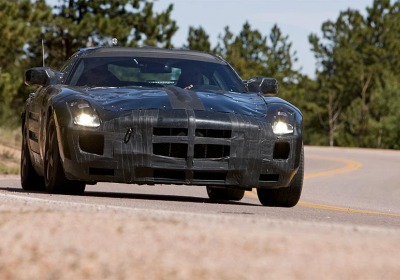Mercedes plans electric version of SLS AMG supercar
Fri, 10 Jul 2009Huge news at Mercedes-Benz: Engineers from its AMG performance-car offshoot are developing a plug-in electric version of the upcoming SLS supercar as part of a broad-based efficiency program to place the automaker at the leading edge of socially acceptable performance-car motoring.
Tentatively planned for production in 2015, the new zero-emission supercar draws heavily on the production version of the yet-to-be-fully-revealed SLS scheduled to get its first public outing at the Frankfurt motor show on Sept. 15.
Remarkably, given the scope of the project, the SLS eDrive is planned to be offered with the same lightweight aluminum body as the production version of the SLS, complete with its signature gullwing style doors.
“The great thing is we haven't had to alter the styling in any way,” says AMG boss, Volker Mornhinweg, adding, “it's completely original in appearance.”
The new car also is set to take the standard interior, with some minor changes to the switchgear to reflect the electric driveline that lurks beneath.
According to official Mercedes-Benz AMG information, the SLS eDrive will use a heavily modified version of the standard SLS's rear-wheel-drive platform. As Mornhinweg points out, “The very nature of the SLS, with its sizeable engine bay, sturdy torque tube running back along the backbone of the car and the mounting point for fuel tank, lends itself perfectly to adaptation for electrification.”
Among the changes aimed at accommodating the new hardware is the inclusion of a new pushrod front suspension that has coil-over dampers mounted horizontally in place of the standard car's more conventional upright double-wishbone arrangement to free up space around the front axle. This allows the fitment of two 98-kilowatt motors up front, effectively making the SLS eDrive a four-wheel drive.
Each of the front wheels is driven via a planetary drive set that acts like a torque-vectoring device, providing drive to the wheel possessing the most traction. The setup at the front is mirrored in back; each rear wheel is powered by a 98kW motor that drives through a planetary drive set, although the standard rear double wishbone has been retained without modification.
All up, the SLS eDrive possesses 392kW and a sturdy 649 lb-ft of torque. By comparison, the standard SLS, powered by a heavily reworked version of AMG's familiar 6.2-liter V8 engine, boasts 571 hp and 479 lb-ft.
Nothing's official just yet, but Wolf Zimmermann, the man heading up SLS eDrive development, claims 0-62-mph acceleration in less than 4.0 seconds and a top speed in excess of 120 mph. This compares with the standard SLS's 3.8 seconds and 196 mph.
Energy for the four individual motors is supplied by a lithium-ion battery that is mounted low in the space usually taken up by the standard SLS's torque tube. AMG also is planning to use the space behind the seats, usually taken up by the fuel tank, for additional capacity. Although Mercedes-Benz is cooperating with Californian-based start-up Tesla on battery technology for its upcoming Smart ED, Mornhinweg says AMG is working with German energy specialist Evonik on the SLS eDrive.
Range is put at between 93 and 112 miles, depending on the load placed on the battery, while overall recharging time is put at between five and six hours on high-density charge or eight hours on conventional mains power. Features such as brake-energy regeneration are envisioned.
AMG's efforts are not confined only to the electrification of the SLS's driveline. “We also want to guarantee a sporting character,” says Mornhinweg, adding, “the goal is to redefine the one-dimensional way electric cars drive today.”
One particular avenue of development being heavily pursued by Mercedes-Benz's fast-car skunk works is the individual apportioning of torque to each wheel; the process allows AMG to more finely tune the handling of its new supercar than with a typical fixed apportioning of torque.
Stung by criticism that its existing lineup lacks environmental credentials, AMG's plans for an electric version of the SLS are well grounded.
“We didn't want to do another concept car without any real relevance to what we're doing today,” explains Mornhinweg. “Instead, we decided to bring the future to us by applying advanced technology we'd already been looking at to a car we're just about to launch.”
Mercedes-Benz apparently is not the only carmaker developing a zero-emission supercar with the view to future introduction. Indications are that its homeland rival Audi also is preparing an electric version of its mid-engine R8 that could appear as early as the Frankfurt motor show. Renowned German aftermarket tuner RUF also has instigated a development program for a heavily modified version of the Porsche 911 propelled purely by electricity that recently prompted Porsche development boss, Wolfgang Durheimer, to admit that internal proposals for a similar car also have been kicked off.
By Greg Kable

